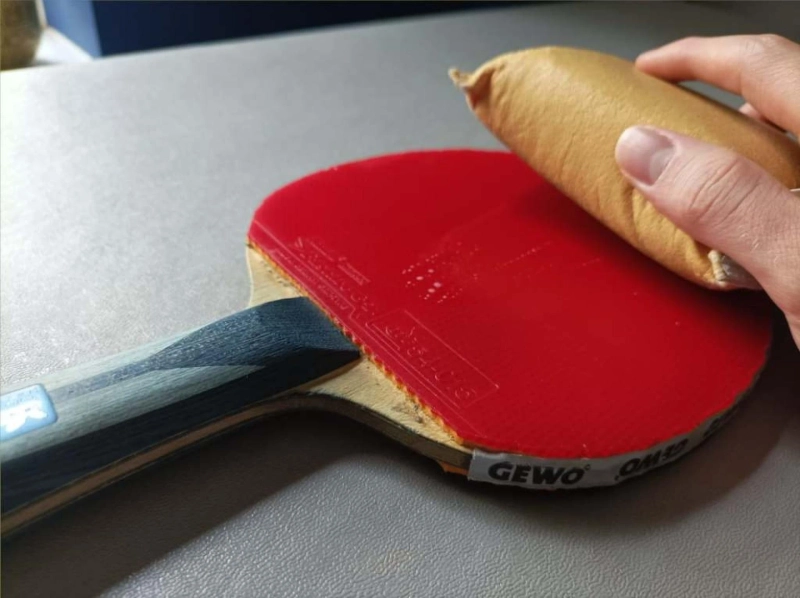Choosing the right table tennis rubber is a crucial factor that affects your playing performance. The decision to select a table tennis rubber must consider several factors, including playing level, playing style, budget, and desired feel. This article will provide essential information to help you choose the most suitable table tennis rubber.
Types of Table Tennis Rubbers
Smooth Rubber (Pimples In)
This type of rubber of ไม้ปิงปอง has a smooth surface, providing excellent ball grip and spin generation.
It consists of a topsheet with pimples facing inwards, placed on a sponge layer.
The thickness of the sponge affects speed and spin generation, generally ranging from 1.5-2.5 mm.
According to ITTF rules, the combined thickness of the topsheet and sponge must not exceed 4 mm.
Pips-Out Rubber
Characterized by pimples protruding outwards.
Two main types:
With sponge - provides a soft and responsive feel.
Without sponge (OX) - provides a direct and easy-to-control feel.
Pips out rubber is divided into 3 categories.
2.1 Short Pimples
The pimples are stiff and do not bend much upon impact.
Suitable for offensive play, spin return, and creating unpredictable shots, such as stop-and-go shots or fast, low flat shots, depending on the short pimple model used.
Recommended models: Dr.Neubauer Killer, Dr.Neubauer Tornado Extreme, Dr.Neubauer Explosion Extreme, Hallmark Illusion
2.2 Half Pimples
The pimples have moderate flexibility, falling between short and long pimples.
They can slightly bend upon impact, return opponent's spin, and be used for counterattacks.
There are 3 main playing styles:
Block style - using half pimples to block opponent's attacks, create disruption, and counterattack when possible.
Offensive style - focusing on attacking, hitting, lifting, and moderately powerful attacks, though not as fast as short pimples.
Defensive style - using half pimples for chopping like long pimples, but with less deception. The advantage is better weight variation than long pimples.
Recommended models: Spinlord Keiler, Dr.Neubauer Aggressor, Dr.Neubauer K.O.
2.3 Long Pimples
The pimples are flexible and bend upon impact, capable of returning opponent's spin.
There are 3 playing styles:
Block style - using the backhand side to create disruption for the opponent.
Offensive style - focusing on attacking, hitting low shots, or using pushing, flicking, and lifting techniques.
Chopping style - using long pimples for chopping to make the pimples collapse or for hitting to return spin and block close to the table.
Recommended models: Dr.Neubauer Viper Soft, Hallmark Tactics LP, Dr.Neubauer Allround Premium 2
Anti-Spin Rubber
Designed to handle spin shots.
When the table tennis ball contacts Anti rubber, if the Anti rubber surface is very slippery, it can return spin like long pimples, but the ball will drop shorter. But this will make the user of anti rubber have a hard time controlling the ball. But if a half anti rubber is used, it will be easier to control, but the rate of returning spin will decrease. Most Anti rubbers are designed to make the ball drop shorter than long pimples.
Suitable for spin reversal and short ball blocking.
Recommended models: Dr.Neubauer A.B.S. 2 Pro, Dr.Neubauer A.B.S. 3 Pro, Spinlord Sandwind, Dr.Neubauer DJango
Choosing Table Tennis Rubbers to Suit Your Playing Style
For Offensive Players
Choose rubbers with high power or effective counterattacking capabilities.
Primarily use smooth rubbers, short pimples, or half pimples.
For high power or speed, choose a sponge thickness of 2.0-2.2 mm (Max).
Offensive play with spin focus:
For both spin and speed, choose rubbers with high sponge flexibility and good spring, such as Gewo Nexxus EL Series, Gewo Codexx Series.
If the main focus is put on spin, then choose a tacky topsheet, such as DHS Hurricane 3 Neo, Sanwei Target National, Tuttle Beijing V National.
Offensive play with hitting focus:
Smooth Rubber: If the main focus is on ball speed or hitting, choose non-tacky rubbers, as they generally have a bouncy topsheet with good energy transfer, resulting in more powerful hits, such as Gewo Nexxus XT, Gewo Nanoflex eft, Tuttle Sky A380.
Short/Half Pips: If the focus is more on attack than defense, choose a thick sponge for speed or a thin sponge for more disruptive effects.
For Defensive Players
Smooth rubber: Choose a soft sponge for better ball control and accuracy.
If the main focus is on blocking, non-tacky topsheets are recommended to reduce errors against high spin shots.
For chopping, choose slightly tacky rubbers to increase the weight of the chop, making it harder for the opponent to attack.
Consider long pimples or anti-spin rubbers, focusing on accuracy and spin reversal effects rather than speed.
Factors to Consider When Choosing Long Pimples or Anti-Spin Rubbers
Sponge Thickness:
Long pimples with sponge are suitable for chopping and playing away from the table, providing more bounce than OX (without sponge). (Except when long pimples are paired with special anti-sponge, in which case the sponge version will provide less bounce.)
OX (without sponge) is suitable for close-to-table play and is easier to control with less bounce.
Durability:
European/Japanese rubbers: 3-4 months lifespan.
Chinese rubbers: 4-5 months lifespan.
After this period, rubber performance may decline.
Avoid storing in hot or humid conditions; store at room temperature and regularly use protective film to extend lifespan.
ITTF Approval:
Use ITTF-approved rubbers for standardized performance and competition eligibility.
Do not modify rubbers illegally, for long term improvement.
Conclusion
Choosing the right table tennis rubber is a process that requires time and experience. No single rubber is suitable for everyone. Experimenting with different rubbers will help you find the one that best suits your playing style. Remember that the most expensive or fastest rubber is not always the best choice. Developing playing skills alongside suitable equipment will effectively enhance your performance.
Source : ยางปิงปอง


